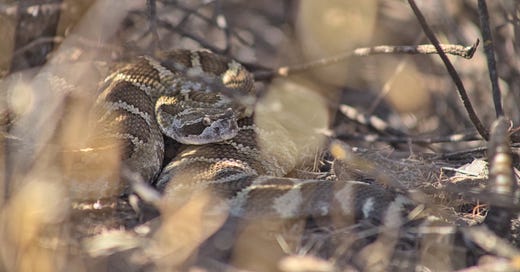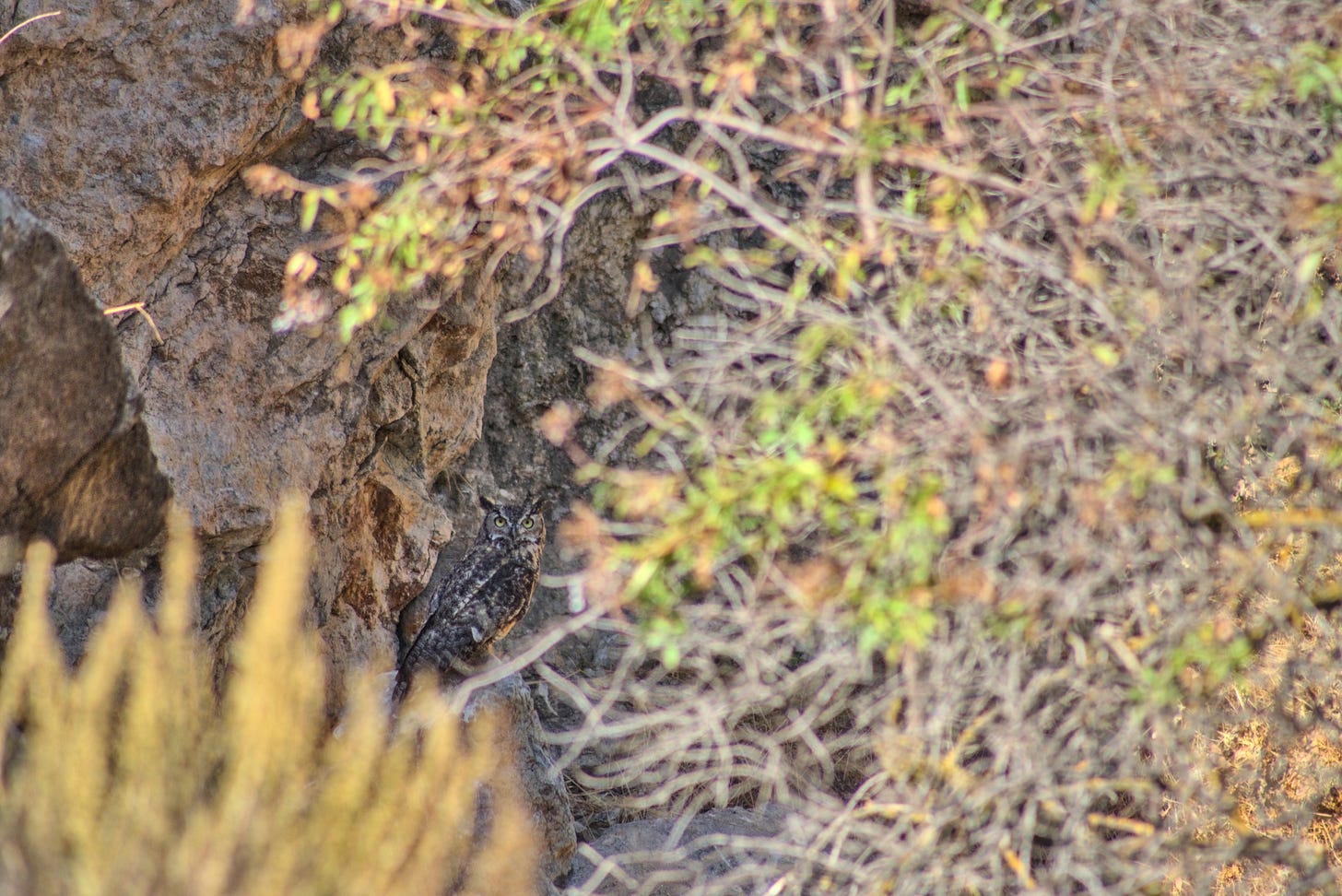It was early October, sunny, and about 75 degrees. I had just arrived to a small temporary stream flowing out of the hills. My plan was to hike, off trail, to some pit mines I found on Apple Maps in the foothills by my house.
The stream flowed by at my right only a small trickle now from a spring, about half a mile up, flowing again from the rains last winter. Over the years the stream has cut down into the ground so that it is in its own miniature gorge up to almost 7 feet deep in some places. The remains of a dead Manzanita, overhanging the mini gorge, were sprawled out and forming a circle of branches pointing outward, an intriguing pattern.
Soon the little canyon the stream flowed through forked and the stream took the left fork. I went down the right fork, which goes in the general direction of the mines. It was about 9:20 in the morning and the sun was right in my eyes as I walked down the little canyon. The sunlight reflected off the grass and made a shimmer that created a whole new beauty to the landscape. As I rounded a corner in the canyon a deer appeared on the side of the hill grazing in the shimmering grass, but was quick to leave upon my presence.
The beauty of the landscape was somewhat marred by large amounts of decorative Halloween spiderwebs floating in the air and catching on the surrounding grass and sagebrush.
As the canyon rose, the grass changed to Hayfield Tarweed, which reeks of a musty smell and is quite sticky. As I walked through, hundreds of insects such as grasshoppers, dragonflies, butterflies, and some strange red and yellow wasps were flushed out of the grass and Tarweed into the air. When I reached the top of where the canyon levels out, I headed south-east to descend another deeper canyon which separated me from the mines.
About halfway down the hillside I paused to drink some water. As I drank I noticed that the Scrub Jays and the Acorn Woodpeckers were being much more noisy than usual. I looked to my left where a Manzanita grew and the birds seemed to be. I was thinking “it must be a bobcat sleeping in the branches.” But no, nor was it the Coyote that was loping away in the sagebrush above me. As I decided to leave because I could not figure out what the birds were yelling at, I saw, out of the corner of my eye, a dark bulky shape fly across the canyon onto a tall California Bay Tree. I lifted my camera and saw in the tree a large Great Horned Owl sitting lazily on a branch with drooping wings, quietly ignoring the raucous chorus directed at it from the surrounding branches. I snapped a few pictures then continued on down.
Great Horned Owls are the largest local owl and are capable of capturing cats and even Barn Owls for food. Normally they are nocturnal, but if they are discovered by other birds their constant annoyances can force the owl to move during the daytime.
As I reached the bottom of the canyon, I entered a riparian forest of Coast Live Oaks and California Bay, through which a stream trickled over the green serpentine rocks in a chorus of sweet bubbling and gushing. Large bushes of Poison Oak grew along the stream side and their bright red leaves gave a flush of Fall color that would otherwise be lacking in the woodland. On either side of the wooded area, the hills rose steeply, dotted with sagebrush and Buckeyes. I reached the place I planned to ascend the hill, at the top of which were the first two mines. It was a steep climb but a short one. When I reached the top I walked around an oak with sprawling branches under which some cows were resting.
I had traveled about one mile by the time I reached the first mines. I passed them by since I’ve visited them twice before and continued on to the to the next two mines, the nearest one still being about 0.3 miles away to the north-east.
The ground had leveled out for a short time before it descended again into a little fold in the hills. It was rocky and infested with Yellow Star-Thistle, an invasive species introduced from the Mediterranean region, that causes tragic amounts of damage to the environment. The thistle displaces native plants along with being quite painful to walk through.
I could hear the soft chuckling of California Quails in the brush to my right, and as I walked past they all flew out in a noisy explosion reminiscent of the sound of a truck engine.
When I crossed the fold, I climbed up on a clear trail, possibly created by the miners so long ago and now maintained by the constant traffic of cows. I wondered how this place has changed since the people who mined these hills for Magnesite last walked here. I imagined them walking with carts of rubble to dump in the large piles that were still visible on the hilltop above. I wondered what life was like in the mines, which were in use about 110-120 years ago.
I like to wonder. I don’t know why. But I’m intrigued by the past and I often wish I could have experienced what life was like back then, without the fast-paced hustle and bustle of modern life. How much more beautiful the landscape must have been.
But as I walked it was hard not to appreciate the beauty the land still possessed. I walked through a small group of Grey Pines, their huge pinecones littering the ground beneath, and their shining needles waving in the wind above. Then finally I reached the third mine. It was a large cutting into the hillside and was overgrown with pines and brush. In the back of the mine I thought I could make out a tunnel. But I promised Mom I wouldn’t go in any mines, so I couldn’t confirm.
By then I was pretty tired from several steep climbs. But I still had one more mine to visit a couple hundred feet above me.
I continued on in some sagebrush. California Sisters flitted over the scrub. A rattling sound by my feet kept on making me look down, expecting to see a rattlesnake, which are abundant in this area. To my disappointment it was just the dry seed pods of some Ithuriel’s Spear. But I was not to be disappointed very long.
As I rounded a corner in the trail I was greeted by a loud, but short, rattle, and sure enough there was a three-foot Rattlesnake curled up under the branches of a sagebrush. It had stopped rattling and was flicking its tongue in annoyance of the untimely interruption of its activities. It was boldly marked with dark blotches and had a slightly green tinge. I crouched down about 5 feet away and snapped some photos, trying to frame its head in the tangle of branches and grass. After about ten minutes of working out a good shot, my legs were cramping in the uncomfortable position I was in, so I got up and left it to its own activities.
By then the climb was getting very steep and I had to zig-zag up the hill to prevent myself from getting too tired.
After about 20 minutes I reached the crest of the hill where the last mine was located. Large piles of rubble about 10-15 feet high surrounded the pit that was deep enough to make you dizzy looking over the edge. On the west and east side of the pit there were dark tunnels that would have barely fit a crouching man.
The crest of the hill was about 1,250 feet above sea level and the view of the valley to the west and the rising hills to the east was spectacular.
I pondered the dramatic changes we have made on the landscape. Its seemed amazing that one species could have such a huge effect on the very physical properties of the Earth. I wished I could have seen the place before all the farms, suburbs, cities, and roads marred the landscape. I was saddened that what once was a beautiful wild place was now buried forever under the pavement of civilization. But I was also glad that I could still appreciate the remaining beauty of God’s creation and there was an assurance that not all of the Earth’s natural beauty would disappear in the future.
Then came the time to head back. I followed the ridge line to an area I knew I could descend easier than the way I had come.
When I reached the first two mines I passed I decided to take one last look. When I reached the edge a dark shape flew across the mine below me. It seemed unable to find a place to perch at first, but when it did I lifted my camera and there was another Great Horned Owl. This one was smaller than the first. It sat perched on the cliff face of the mine peering at me with its bright yellow eyes. Soon it flew away into the other mine followed by a second larger owl. After a little searching I couldn’t see them in the other mine.
By now I was quite tired. But I had seen a lot more than I was hoping and was looking forward to inspecting my photos of the rattlesnake and owls.
I have always enjoyed hiking in the quietness of the hills and being able to sit and think without other distractions going on around me. The refreshing properties of being in nature is something I think I will always crave.
For thus says the LORD, who created the heavens,
Who is God, who formed the earth and made it, who established it
Who did not create it in vain, who formed it to be inhabited:
“I am the LORD, and there is no other.”
Isaiah 45:18
Jasper Jonnalagadda 2023






Nice work Jasper. I would love to hike those trails with you and explore some of those mine shafts as well. Where did this story take place? Almaden Quicksilver?